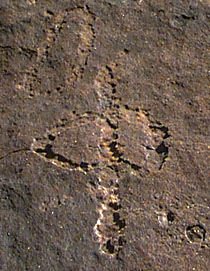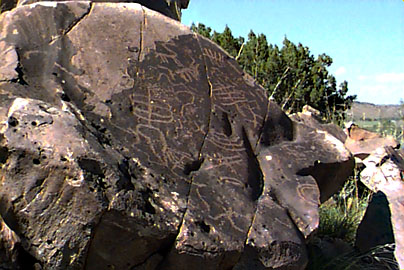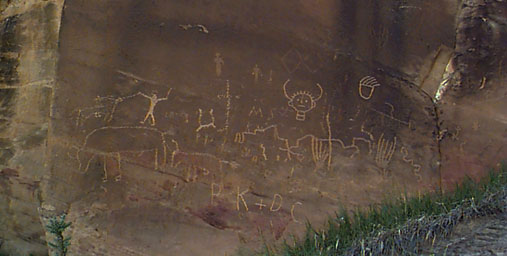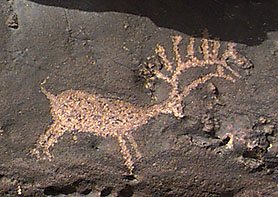|
The Mystery of Ancient America's

Canyon People ViewZone will attempt to give you all the details.
We welcome your comments, analysis and speculations.
| We woke up early. The position of the sun effects the visibility of the petroglyphs. The alphabetical petroglyphs are pecked (as opposed to scraped or painted) on to the stone by some sharp tool. Experiments have shown that a sharp piece of flint, held in the hand, is excellent for this purpose.
The rock typically has a black coating or patina which is the result of thousands of years of deposition. Bacteria and chemical reactions with magnesium and iron in the rock coat the surface like hard tar. The early "carvers" of these stones would have chipped away the patina to reveal the brightly colored rock below, some of which is almost white. The original petroglyphs would have been quite visible and would have had excellent contrast. Today, the passage of time has allowed the same chemical reactions to form a new patina over the carved surface and measuring this later patina is a good clue to the age that they were first made. The carved petroglyphs are as black inside as the rock surface from which they were carved. Laboratory analysis of this newer patina has been carried out on a few selected grooves of the Picket Wire Canyon petroglyphs. This placed possible ages for some of these petroglyphs to be from 2000 to 3000 years old. Some look much, much older. | 
|

When you first see them, your eyes focus on the more contrasted and relatively newer Plains Indian art. The themes of these carvings deal horses, shaman and other human shapes. Plains Indian art is often scraped, not pecked, into the stone. When lit from the side, artificially or by the angle of the sun, the faint depressions of the older, more shallow and blackened marks readily reveal themselves. Bill and his associate, Ted Barker, have visited every site at every time of day. And so it was a matter of the position of the sun that dictated our hurried schedule to various canyon walls in the early morning and late evening afternoon.

Look closely and you will see all four styles of petroglyphs on these rocks (pictured above and below). The meandering lines are examples of the abstract form, the tree-like figures are examples of the mysterious alphabet in compound form, the animals are likely Plains Indian marks and there are occasionally names and dates scratched into the collection.
Our first stop was just a few miles south of La Junta. The rocks were perfectly illuminated by the sun from the side. We clearly saw all four of the styles that both Bill and Ted had cataloged. There was the oldest abstract shapes and meandering lines and spirals. Then there was the mysterious alphabet, the Plains Indian renderings of animals and spirits, and finally the recent "cowboy art" and graffiti. 
The graffiti and Plains Indian art was obvious. Its color and the depth of the grooves indicated it was much younger than the barely visible ancient marks. The intent was to create symbols or pictures that told a story. We couldn't understand them but, from Martineau's work, we were sure that they could be read. But they were symbols and pictures, not an alphabet. And their appearance on the rocks obscured the oldest layers of the black rock.
|
Some of the older petroglyphs were familiar to us. Goats heads with horns swept back, a deer-like animal with multiple antlers, and the ever present spiral and sun signs that we had seen in the Hopi Sun Park. Contrary to what we had been told in Chinle, this sign was frequently indicative of a solar alignment where a particular shadow would be cast on the spiral at a unique time of the year, usually at sunrise. Other spirals did not appear to have been intended for such alignments but were symbolic of the sun itself. These spirals seemed to be of the much older type of petroglyph, often blackened and faint like the ancient alphabet.
|  |
While Viewzone takes dozens of photographs, our local guides, Bill and Ted, assure us that "the best is yet to come."
<--back-- | --more--> |






